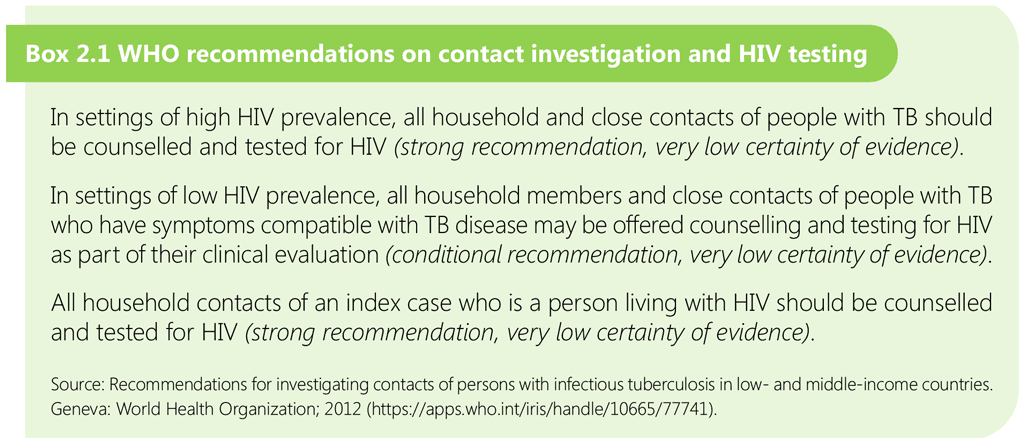Book traversal links for 2.2.1 Prioritizing household contacts
Household contacts of people with PTB are a well-recognized group at risk for TB infection and TB disease, including prevalent TB detected at the time of initial contact investigation and incident TB that occurs within the subsequent 2–5 years (15). WHO recommends that household contacts and other close contacts of people with PTB should be systematically screened for TB disease (14). Contact investigation can be implemented at the health facility, in the community or through a combination of these approaches.
A systematic review and meta-analysis estimated the risk of developing TB disease in children (defined in this study as people aged under 19 years) after close exposure and how this risk was affected by TPT, BCG vaccination and time since TB exposure (16). The review found that exposed infants who had evidence of TB infection and did not receive TPT had an 18% risk of developing TB disease within 2 years of being evaluated as a contact. In contrast to previous estimates that suggested the risk is lower for children aged 2–5 years, this study found that this age group had an equally high risk of developing TB within 2 years (19%). The effectiveness of TPT to prevent the development of TB disease was estimated at 91% for children and adolescents with TB infection.
Another important finding of the review was that 61% of children and adolescents and 83% of all children aged under 5 years with TB infection who developed TB disease did so within weeks of the initial contact investigation.
The review confirmed that younger children, especially those aged under 2 years, are at particularly high risk of TB disease progression after infection (4), and that contact investigation reaches many children too late to prevent disease. Considering that 80% of paediatric deaths from TB occur in children aged under 5 years (17), earlier diagnosis of infectious adults and timely TB screening, diagnosis and treatment of children who are contacts are important approaches to reduce TB disease and deaths in children (16).
Other studies also highlight the importance of contact investigation. Results of the PHOENIx feasibility study from eight high TB burden countries showed that contact investigation helped detect new TB disease in 12% of contacts. The prevalence of TB infection (defined as either TST or interferon-gamma release assay (IGRA) positivity) in this group was 72% (18). Thus, screening household contacts for TB disease is considered a high priority because it is a high-yield, cost-effective strategy (19). Contact investigation links to effective interventions such as treatment for TB disease and TPT, helps prevent transmission, and improves TB treatment outcomes for contacts. It is also a key strategy for TB infection prevention and control.
Investigation and treatment of all household contacts can provide important health and financial benefits for the family. The occurrence of TB in a family can have serious social and economic effects, including catastrophic costs due to loss of income or charges for health care. Offering TPT to all household members at the same time and during the period when the index patient is still receiving treatment and care can help maximize the understanding and impact of TPT and enhance cost-effectiveness of interventions such as home visits.
WHO recommendations on HIV testing for TB contacts are listed in Box 2.1.


 Feedback
Feedback